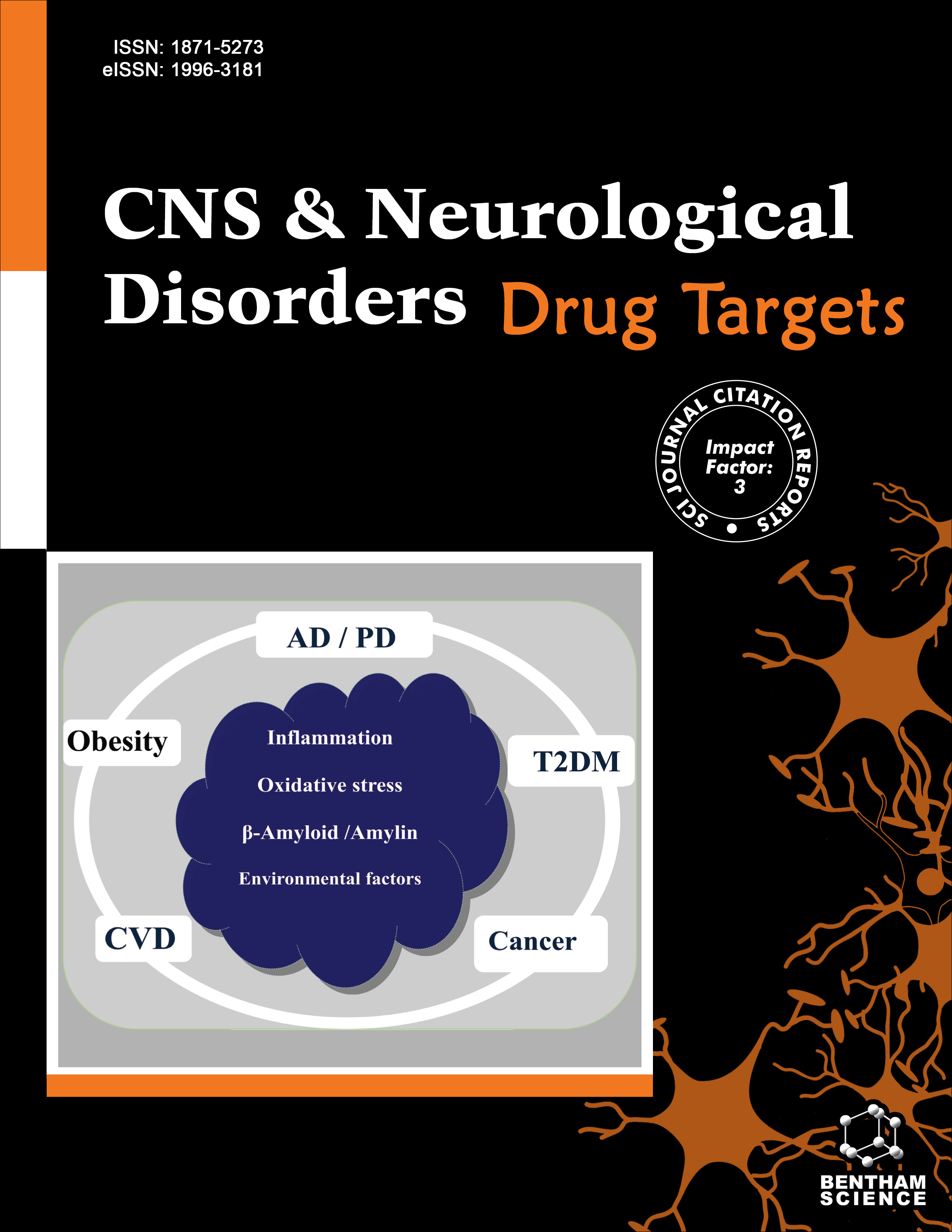- Home
- A-Z Publications
- CNS & Neurological Disorders - Drug Targets (Formerly Current Drug Targets - CNS & Neurological Disorders)
- Previous Issues
- Volume 16, Issue 9, 2017
CNS & Neurological Disorders - Drug Targets (Formerly Current Drug Targets - CNS & Neurological Disorders) - Volume 16, Issue 9, 2017
Volume 16, Issue 9, 2017
-
-
Genetic Signatures in Ischemic Stroke: Focus on Aspirin Resistance
More LessAuthors: Kanika Vasudeva, Pratibha Chaurasia, Sulena Singh and Anjana MunshiBackground and Objective: Stroke is one of the leading causes of death. There has been compelling evidence that stroke has a genetic component. Genetic variants not only influence susceptibility to stroke but have also been found to alter the response to pharmacological agents and influence the clinical outcome of the disease. Stroke patients are treated with antiplatelet drugs like aspirin and clopidogrel to prevent a secondar Read More
-
-
-
Implications of PEGylation of Carbon Nanotubes for Central Nervous System Bioavailability
More LessBackground and Objective: In this mini-review, we have compiled the most recent and comparable information to shed light on the action of PEGylation in the biodistribution of carbon nanotubes (CNT) in the central nervous system (CNS). It is well known that due to the complexity of the CNS and the severity of the outcome following changes in this system, this is one of the areas where there are more investments in rese Read More
-
-
-
The 18-kDa Translocator Protein as a CNS Drug Target: Finding Our Way Through the Neuroinflammation Fog
More LessAuthors: Michaela D. Filiou, Richard B. Banati and Manuel B. GraeberBackground & Objective: The 18-kDa translocator protein (TSPO) is located in the outer mitochondrial membrane where it is thought to co-regulate steroidogenesis, cellular bioenergetics as well as several other cellular processes. Originally discovered as a binding site for diazepam outside the CNS, notably in steroidogenic tissue and mononuclear phagocytes, the TSPO's historical designation was peripheral benzodiazepine rece Read More
-
-
-
MicroRNA Dysregulation in Alzheimer's Disease
More LessAuthors: Manish Putteeraj, Yahaya M. Fairuz and Seong Lin TeohBackground and Objective: Alzheimer's disease (AD) is arguably the largest healthcare issue of our time. AD is thought to be principally the result of an inter-play between the β-amyloid peptide and Tau, and it is driven by several genetic and environmental risk factors. Recent studies have shown that small non-protein-coding microRNA (miRNA) and the associated post-transcriptional gene regulation are important regulators of m Read More
-
-
-
Chromosomal Micro-aberration in a Saudi Family with Juvenile Myoclonic Epilepsy
More LessBackground and Objective: Epilepsy is etiologically and genetically complex neurological disorder affecting millions of people worldwide. Juvenile myoclonic epilepsy (JME) is the most common epilepsy syndrome that starts in the teen age group commonly between ages 12, 18, and lasts till adulthood. One out of fourteen people with epilepsy suffers with JME. Myoclonic seizures and muscle twitching or uncontrolled jerking ar Read More
-
-
-
Natalizumab Changes the Peripheral Profile of the Th17 Panel in MS Patients: New Mechanisms of Action
More LessIntroduction: Natalizumab (NAT) is an effective treatment for relapsing remitting multiple sclerosis (RRMS), as it makes the blood-brain-barrier impenetrable by binding to the α4integrin subunit. The objectives of our study were to find new peripheral mechanisms of action of NAT and new biomarkers of treatment response. Material and Methods: We prospectively assessed the serum levels of 15 cytokines from the Th17 Cy Read More
-
-
-
Identification of Electrophysiological Changes in Alzheimer's Disease: A Microarray Based Transcriptomics and Molecular Pathway Analysis Study
More LessAuthors: Zeenat Mirza and Nisreen RajehBackground & Objective: Involvement of amyloid beta and tau proteins in pathogenesis of Alzheimer's disease (AD) has been studied extensively. However, electrophysiological activity, and cellular processes like membrane transport are mostly unstudied. Electrophysiological processes provide a bridge between brain activity and cognition, and show promise as translatable biomarkers in preclinical and clinical applications. Bioch Read More
-
Volumes & issues
-
Volume 24 (2025)
-
Volume 23 (2024)
-
Volume 22 (2023)
-
Volume 21 (2022)
-
Volume 20 (2021)
-
Volume 19 (2020)
-
Volume 18 (2019)
-
Volume 17 (2018)
-
Volume 16 (2017)
-
Volume 15 (2016)
-
Volume 14 (2015)
-
Volume 13 (2014)
-
Volume 12 (2013)
-
Volume 11 (2012)
-
Volume 10 (2011)
-
Volume 9 (2010)
-
Volume 8 (2009)
-
Volume 7 (2008)
-
Volume 6 (2007)
-
Volume 5 (2006)
Most Read This Month
Article
content/journals/cnsnddt
Journal
10
5
false
en

Most Cited Most Cited RSS feed
-
-
A Retrospective, Multi-Center Cohort Study Evaluating the Severity- Related Effects of Cerebrolysin Treatment on Clinical Outcomes in Traumatic Brain Injury
Authors: Dafin F. Muresanu, Alexandru V. Ciurea, Radu M. Gorgan, Eva Gheorghita, Stefan I. Florian, Horatiu Stan, Alin Blaga, Nicolai Ianovici, Stefan M. Iencean, Dana Turliuc, Horia B. Davidescu, Cornel Mihalache, Felix M. Brehar, Anca . S. Mihaescu, Dinu C. Mardare, Aurelian Anghelescu, Carmen Chiparus, Magdalena Lapadat, Viorel Pruna, Dumitru Mohan, Constantin Costea, Daniel Costea, Claudiu Palade, Narcisa Bucur, Jesus Figueroa and Anton Alvarez
-
-
-
- More Less

